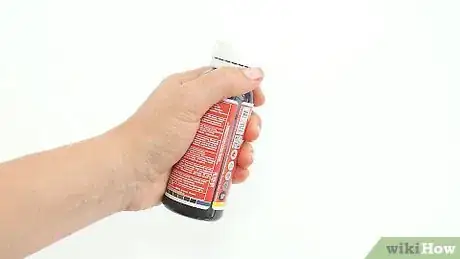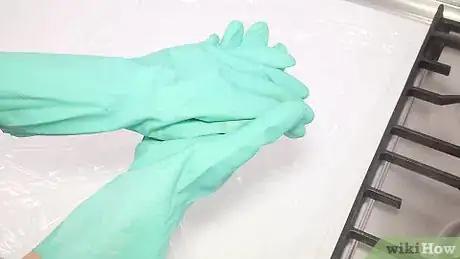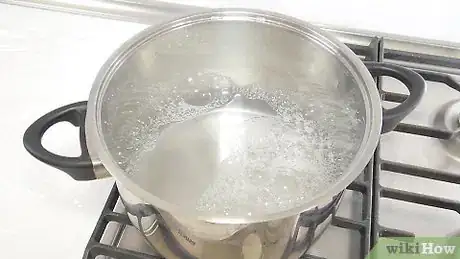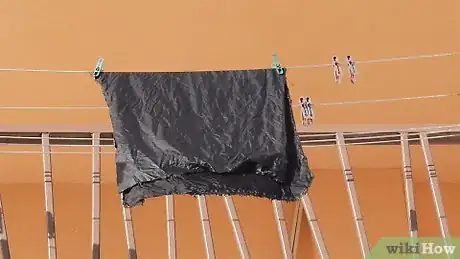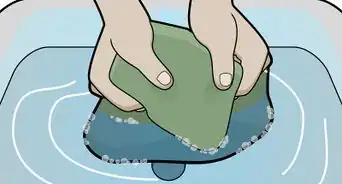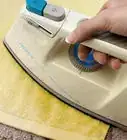This article was co-authored by wikiHow staff writer, Hannah Madden. Hannah Madden is a writer, editor, and artist currently living in Portland, Oregon. In 2018, she graduated from Portland State University with a B.S. in Environmental Studies. Hannah enjoys writing articles about conservation, sustainability, and eco-friendly products. When she isn’t writing, you can find Hannah working on hand embroidery projects and listening to music.
There are 7 references cited in this article, which can be found at the bottom of the page.
The wikiHow Video Team also followed the article's instructions and verified that they work.
This article has been viewed 17,245 times.
Learn more...
Dyeing synthetic fabrics like nylon, acrylic, acetate, and polyester can be a pain since they don’t pick up the dye as well as natural fibers. This can be frustrating, especially if you have perfectly good fabric in the wrong color for your project. Fortunately, if you use fabric dye specifically made for synthetic fabrics, you can transform your fabric into a deep, rich black that’s perfect for your craft.
Steps
Preparing Your Fabric and Work Area
-
1Weigh your fabric to see how much dye you need. Fold up your fabric and place it on a kitchen scale. Weight it in pounds to see how much dye you’ll need to add to cover the entirety of your fabric.[1]
- Usually, you need to use 1 bottle of dye for every 2 pounds (0.91 kg) of fabric.
- Check on the back of the bottle of your fabric for the specific amount of dye you need to use.
-
2Purchase a black dye made specifically for synthetic fabric. Synthetic fabrics, like polyester, nylon, acrylic, and acetate take dye differently than natural fibers. Make sure the dye you are purchasing says that it is specifically for synthetic fabrics so you know that it will work.[2]
- You can find synthetic fabric dye at most craft supply stores. Rit Dye, Jacquard Dye, and Dylon Dye make synthetic dyes in a liquid or powder form.
Advertisement -
3Wash the fabric like you normally would. Check the care instructions on the label of your fabric and wash it with water and detergent. Rinse it out well so there isn’t any detergent left before you start dyeing.[3]
- Pre-washing the fabric will remove any coatings that could be on the outside of the fabric from manufacturing.
-
4Cover your work surface and put on gloves. Fabric dye can and will stain your skin and your work surface. Use a plastic tarp or paper bags to cover the area you’ll be working in, and use rubber gloves to protect your hands.[4]
Tip: Rubber gloves are better than latex or nitrile ones because they protect your hands from the heat of the water as well.
Mixing the Dye
-
1Fill a stainless steel pot with water. You can estimate how much water you need by putting your fabric into the pot and seeing how much room it takes up. Use enough water for your fabric to move around freely in the pot.[5]
- Usually this is about 3 pounds (1.4 kg) of water for every 1 pound (0.45 kg) of fabric.
- Stainless steel won’t stain when it comes into contact with the dye.
-
2Add 1 teaspoon (4.9 mL) of dish soap to the water. Try to use a mild dish soap without any fragrances or dyes. The dish soap helps to reduce the surface tension of the water, which will allow the dye to penetrate your fabric.[6]
- Some fabric dyes recommend that you add salt or vinegar to the mixture, but you don’t have to do that with synthetic dyes.
-
3Bring the water to just below a boil on the stove. Turn your stovetop to medium-high heat and let it sit. Watch for small bubbles that begin to rise to the surface of the water, then turn your heat down so that it stays at that level.[7]
- If your water does start to boil, just turn your heat down slightly and wait for the water to cool down.
- Non-synthetic dye doesn’t have to be mixed with hot water, but synthetic dye does.
-
4Pour your dye into the water and stir it around. Read the instructions on your package of dye to figure out how much you need for your fabric. Use a metal spoon to stir the dye well so that it is evenly mixed into the water.[8]
Warning: If you use anything non-metallic to stir your pot, it will most likely get stained with dye.
Dyeing, Washing, and Drying the Fabric
-
1Wet your fabric, then add it to the pot. Quickly run your fabric under the sink and wring out the excess water. Lower it down gently into the pot of dye, making sure you don’t splash yourself.[9]
- You can use tongs to put your fabric into the water if it’s easier.
-
2Stir your fabric for 10 to 30 minutes. If you want your fabric lighter, take it out earlier. If you want it a darker color, keep it in for the full 30 minutes. Keep stirring your fabric constantly so that it moves around the pot the entire time it’s in the dye.[10]
- Nylon reacts super quickly to dye, while polyester can take a long time to pick up the dye.
Tip: Your fabric will look darker when it’s wet than it actually looks when it’s dry.
-
3Rinse the fabric in warm water until the water runs clear. Use tongs to take your fabric out of the water, and remember that it will be super hot. Rinse it with warm water in the sink until you can’t see any dye running out, or for about 5 minutes.[11]
- Make sure you are wearing your gloves, or the dye will stain your hands.
-
4Wash the fabric in warm water with detergent. You can hand wash your fabric or put it into the washing machine on its own. Use warm water and a few drops of detergent to wash and rinse your dye.[12]
- The dye will probably run the first time you wash your fabric, so it’s important to wash it on its own.
-
5Hang the fabric to dry. Fold your fabric over a clothes rack or clothesline and wait until it’s fully dry. Now you can use your fabric in sewing clothes, doing embroidery, or other crafts![13]
Warnings
- Use rubber gloves to protect your skin from the dye and the heat of the water.⧼thumbs_response⧽
Things You’ll Need
- Black dye
- Stainless steel pot
- Gloves
- Paper bags or plastic
- Dish soap
- Wooden spoon
- Tongs
- Clothes rack
References
- ↑ https://www.youtube.com/watch?v=hoR6w_j281I&feature=youtu.be&t=40
- ↑ https://static1.squarespace.com/static/5ac4eb022971149bb6d709d3/t/5b3e48d6758d464359bb5716/1530808534482/Basic+Dye+Instructions.pdf
- ↑ https://www.youtube.com/watch?v=hoR6w_j281I&feature=youtu.be&t=27
- ↑ https://www.ritdye.com/instructions/how-to-use-dyemore-for-synthetic-fibers/
- ↑ https://www.youtube.com/watch?v=GrgqdWvYags&feature=youtu.be&t=20
- ↑ https://www.ritdye.com/instructions/how-to-use-dyemore-for-synthetic-fibers/
- ↑ https://static1.squarespace.com/static/5ac4eb022971149bb6d709d3/t/5b3e48d6758d464359bb5716/1530808534482/Basic+Dye+Instructions.pdf
- ↑ https://www.youtube.com/watch?v=GrgqdWvYags&feature=youtu.be&t=42
- ↑ https://www.ritdye.com/instructions/how-to-use-dyemore-for-synthetic-fibers/
- ↑ https://static1.squarespace.com/static/5ac4eb022971149bb6d709d3/t/5b3e48d6758d464359bb5716/1530808534482/Basic+Dye+Instructions.pdf
- ↑ https://www.youtube.com/watch?v=GrgqdWvYags&feature=youtu.be&t=92
- ↑ https://www.ritdye.com/instructions/how-to-use-dyemore-for-synthetic-fibers/
- ↑ https://static1.squarespace.com/static/5ac4eb022971149bb6d709d3/t/5b3e48d6758d464359bb5716/1530808534482/Basic+Dye+Instructions.pdf

